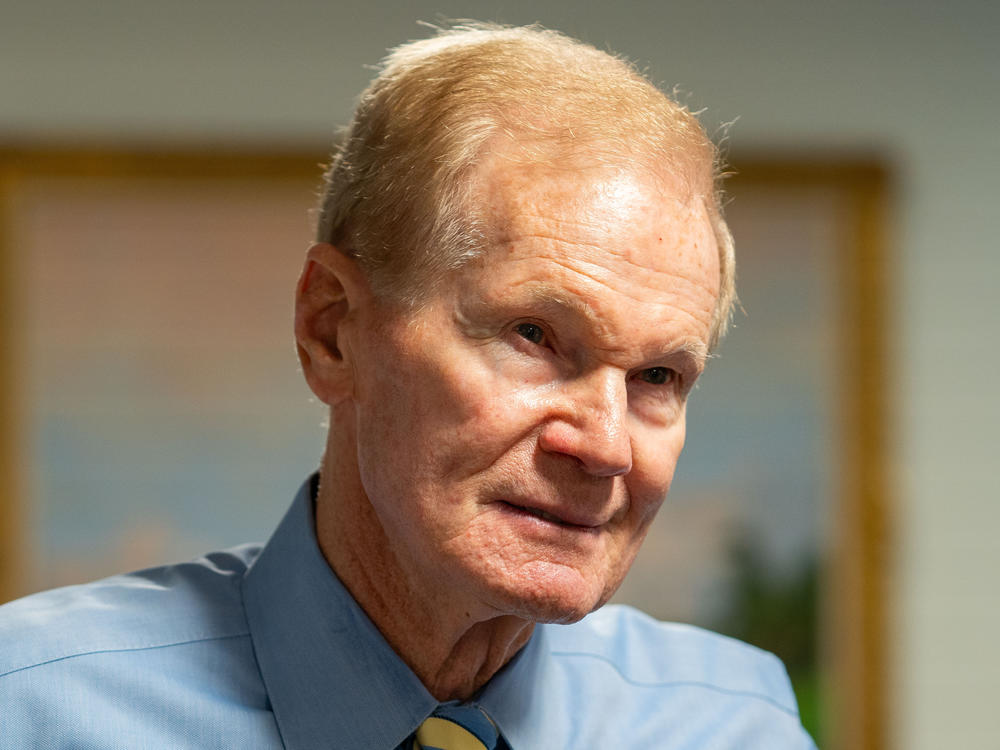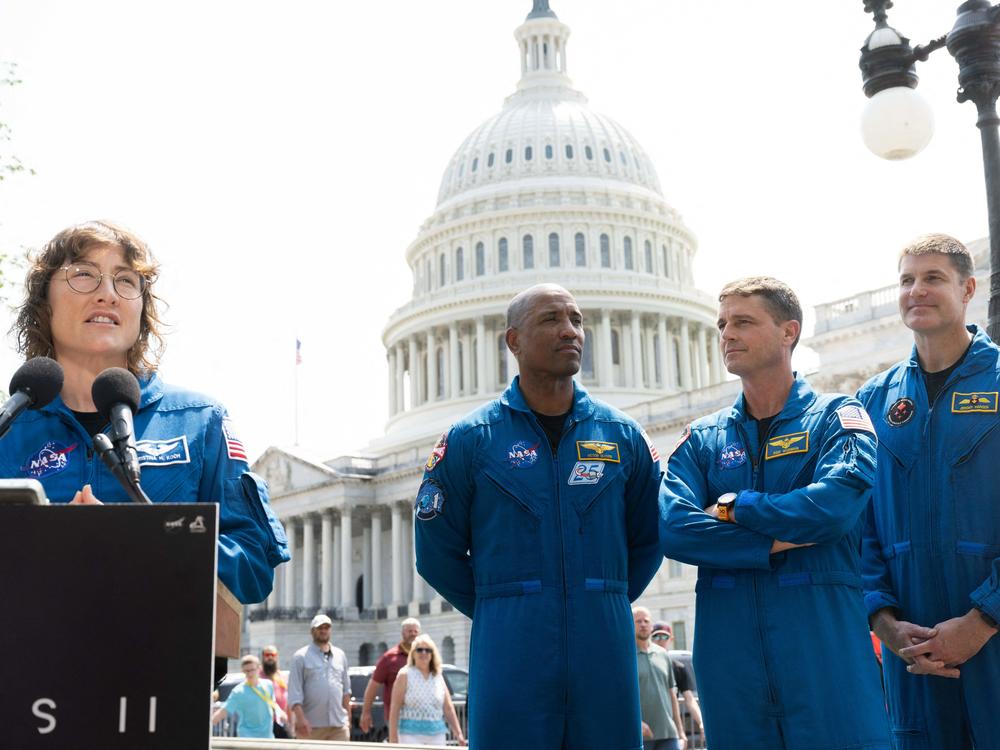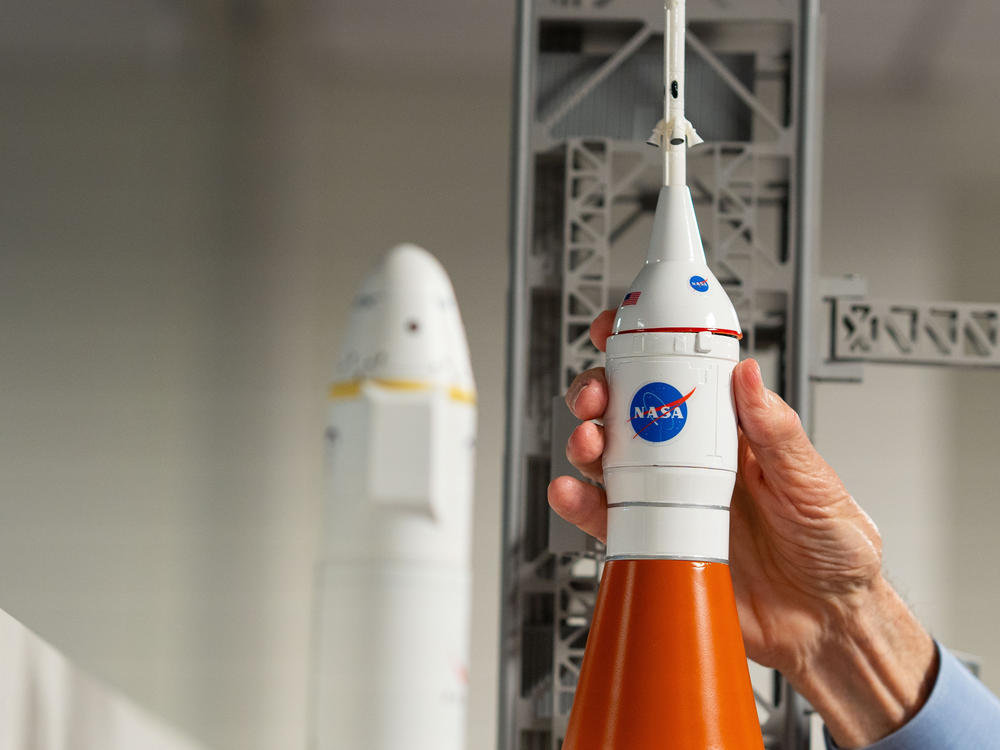Section Branding
Header Content
NASA's chief is worried about China getting back to the moon first. Here's why
Primary Content
There's a moon rock in the lobby of NASA's Washington, D.C., headquarters.
Visitors are urged to rub their fingers over its smooth, worn surface to connect with one of the greatest achievements in human history: the Apollo missions that landed 12 American men on the moon.
The rock is from the very last visit: Apollo 17, which returned to Earth in 1972. No one has returned to the moon since.
And while NASA has done astonishing things over and over since Apollo — in recent years alone, it's flown a helicopter on Mars, smashed a spacecraft into an asteroid, and begun to redefine our basic understandings of space with the James Webb Space Telescope — the glory days of the moon landings feel, at times, like ancient history.
NASA is aiming to change that, and soon. The Artemis program, if all goes according to schedule, will return American astronauts to the moon within the next few years.
The United States isn't alone, though.
China is hoping to land astronauts on the moon by the end of the decade. Last week, it launched a probe to gather samples from the far side of the moon, with the goal of returning them to Earth. India and other countries have landed uncrewed craft on the moon in recent years as well.
This time around, the space race isn't just about who gets there first. It's a race for resources, such as water, which could fuel further space exploration to Mars and other destinations.
NASA Administrator Bill Nelson recently spoke to All Things Considered about the agency's ambitious goals for the coming decade. He told host Scott Detrow he sees the U.S. in an urgent race with China, and that he trusts SpaceX, despite Elon Musk's increasingly controversial profile. He also looked forward to Monday's scheduled Boeing Starliner test flight.
This interview has been lightly edited for length and clarity.
Interview highlights
Scott Detrow: What is the goal here? What is the urgency in here that makes [returning to the moon] much more close to reality?
Bill Nelson: The goal is not just to go back to the moon. The goal is to go to the moon to learn so we can go farther to Mars and beyond. Now it so happens that we're going to go to a different part of the moon. We'll go into the South Pole, and that is attractive because we know there's ice there in the crevices of the rocks in the constant shadow or darkness. And if in fact there is water, then we [can create hydrogen] rocket fuel. And we're sending a probe later this year that is going to dig down underneath the surface on the South Pole and see if there is water.
But you go to the moon and you do all kind of new things that you need in order to go all the way to Mars. The moon is four days away. Mars, under conventional propulsion, is seven or eight months. So we're going back to the moon to learn a lot of things in order to be able to go further.
Detrow: Lay out for me what the timeline is for Artemis right now, because this was the year that that first mission was supposed to take a crew to circle the moon. That's been delayed. What are we looking at right now?
Nelson: Understand, we don't fly until it's ready because safety is paramount. But the plan is September of next year, 2025, that the crew for three Americans and a Canadian will circle the moon and check out the spacecraft.
Then the contractual date with SpaceX [to deliver the rocket for Artemis 3 to take astronauts to the moon], a fixed price contract is one year later, September of 2026.
Detrow: You said that nobody's going to go until they're ready. Well, as you know, the Government Accountability Office had a report late last year raising serious concerns and skepticism about the timeline that you laid out. Do you share that concern? Do you feel like this timeline is realistic?
Nelson: Well, all I can do is look to history. When we rush things, we get in trouble and we don't want to go through that again. I was on the space shuttle 10 days before the Challenger explosion, and that is something you just don't want to go through.
Seventeen astronauts have given their lives. Spaceflight is risky, especially going with new spacecraft and new hardware to a new destination.
That's why this launch of the Boeing Starliner, it's a test flight. The two astronauts, both [Butch Wilmore] and [Sunita Williams] are test pilots. If everything works well, then the next one will be the starting of a cadence [of regular launches] of four astronauts in the Starliner.
Detrow: You mentioned SpaceX, you mentioned Boeing. This is a big part of this current plan, utilizing private companies in a much different way. I do want to ask, though, SpaceX has had so much success when it comes to space flight, but Elon Musk's decision-making has come under a lot of scrutiny in recent years when it comes to some of his other companies, Twitter and Tesla. His engagement in culture war politics. Are you concerned that so much of this plan is in the hands of Elon Musk at this point in time?
Nelson: Elon Musk ... one of the most important decisions he made, as a matter of fact, is he picked a president named Gwynne Shotwell. She runs SpaceX. She is excellent. And so I have no concerns.
Detrow: When you [were testifying before Congress] the other day, a lot of the questions came back to China. And in speeches you have given, you keep coming back to China as well. Why is it key to you? Why does it matter so much that the U.S. beats China back to the moon?
Nelson: First of all, I don't give a lot of speeches about China, but people ask a lot of questions about China. And it's important simply because, I know what China has done on the face of the Earth, for example, where the Spratly Islands, they suddenly take over a part of the South China Sea and say, "this is ours, you stay out."
I don't want them to get to the South Pole, which is a limited area where we think the water is. It's pockmarked with craters. And so there are limited areas that you can land on the South Pole. I don't want them to get there and say, "this is ours. You stay out."
It ought to be for the international community, for scientific research. So that's why I think it's important for us to get there first.
Detrow: The U.S. is part of a lot of different treaties in terms of, you know, sharing its work with other countries. I guess people in China might hear that and say, "we're concerned the U.S. would do the same."
Nelson: Well, but we are the instigators with the international community, now upwards of 40 nations ... of the Artemis Accords, which are commonsense declarations about the peaceful use of space, which includes working with others, which includes going to somebody else's rescue, having common elements. ... But China and Russia have not [signed on].
Detrow: This is being framed in the same space race terms in many ways: the U.S. versus China. Is that how you see it?
Nelson: With regard to going to the moon? Yes.
Detrow: And that's specifically about making sure that that those resources around the South Pole are protected.
Nelson: And the peaceful uses for all peoples. That's basically the whole understanding of the space treaty that goes back decades ago. It is another iteration of the declaration of the peaceful uses of space.
Detrow: How else can the U.S. ensure that other than getting there first?
Nelson: We've got a lot of partners. And the partners generally, you know, nations that get along with China as well as nations that get along with Russia. By the way, we get along with Russia. Look, ever since 1975 in civilian space, we have been cooperating with Russia in space.
Detrow: And that's continued throughout the Ukraine war, in space.
Nelson: Without a hitch.
Detrow: So with China, how do you balance the speed and urgency and concern that you feel with the safety element that we talked about before? Because both are very important to you.
Nelson: We don't fly until it's ready. That's it.
Detrow: When you were on the Hill the other day, a lot of the questions had to do with resources, but also concern that China might be viewing lunar activity through a military prism. Do you share that concern?
Nelson: I do.
Detrow: Can you tell us what specifically you're concerned about?
Nelson: Well, I think if you look at their space program, most of it has some connection to their military.
Detrow: What's the solution to that then from the U.S. perspective?
Nelson: Well, take history. In the middle of the Cold War, two nations realized they could annihilate each other with their nuclear weapons. So was there something of high technology that the two nations — Russia, in this case, the Soviet Union, and America could do?
And an Apollo spacecraft rendezvoused and docked with a Soviet Soyuz. And the crews lived together in space. And the crews became good friends. Now that says a lot.
So that's what history teaches us that we can overcome. I would like for that to happen with China. But the Chinese government has been very secretive in their space program, their so-called civilian space program.



